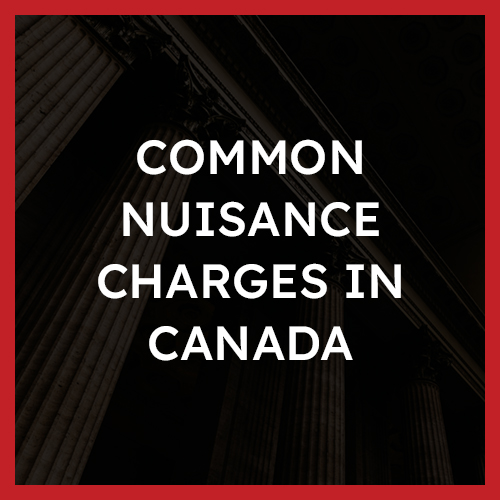Common Nuisance (s. 180) Laws in Canada
What is Common Nuisance?
Common Nuisance is an offence under Section 180 of the Criminal Code of Canada.

Examples of Common Nuisance:
Some examples of the offence of Common Nuisance may include:
- A person intentionally urinates in a water jug at a public event, where others are likely to consume water from the jug.
- A person knows they have HIV, does not treat the illness, and donates blood, without disclosing their HIV status
Defences
- No Offence of Legal Duty
- No Injury, Obstruction, or Danger
- Lack of Knowledge/ Intent
A defence to common nuisance may consist of an accused person’s lack of knowledge of awareness that their actions would be likely to endanger the health and safety of others. This should be discussed with a lawyer during consultation.
Punishment
The maximum penalty for a conviction under Section 180 is two years imprisonment. Specifically, Section 180 (1)(b) provides that everyone who commits Common Nuisance is guilty of an indictable offence and is liable to imprisonment for a term of not more than two (2) years
Whether you intend to plead guilty to a charge under section 180, it is important to consult a lawyer prior. There may be factors which apply to your punishment/sentencing which are relevant and important for consideration, which may result in a lesser punishment.
Overview of the Offence
Section 180 of the Criminal Code states:
Common nuisance
180 (1) Every person is guilty of an indictable offence and liable to imprisonment for a term of not more than two years or is guilty of an offence punishable on summary conviction who commits a common nuisance and by doing so
(a) endangers the lives, safety or health of the public, or
(b) causes physical injury to any person.
Definition
(2) For the purposes of this section, every one commits a common nuisance who does an unlawful act or fails to discharge a legal duty and thereby
(a) endangers the lives, safety, health, property or comfort of the public; or
(b) obstructs the public in the exercise or enjoyment of any right that is common to all the subjects of Her Majesty in Canada.
Section 180(1) of the Criminal Code of Canada is a provision that criminalizes the commission of a common nuisance. A common nuisance is defined as any activity or act that is likely to endanger the lives, safety, or health of the public or cause physical harm to any person. This offence is indictable, and the offender is liable for a term of imprisonment for a maximum of two years.
In order for a person to be convicted of Common Nuisance in criminal court, the crown is required to prove their case beyond a reasonable doubt. The crown must also prove several elements of the offence. Proving the offence should include: confirming the accused’s identity, the date(s) and time(s) which the incident(s) occurred, the jurisdiction, that the accused had knowledge that their actions were likely to endanger the lives, safety, or health of the public or to any person.
The presumption of innocence applies in that the accused is presumed innocent until convicted of the offence.
The Guilty Act (Actus Reus)
The actus reus for the offence of Common Nuisance is established by proof, beyond a reasonable doubt, of the following:
- the accused’s actions endangered the lives, safety or health of the public, or caused physical injury to any person.
The Guilty Mind (Mens Rea)
The mens rea for Common Nuisance is established by proof, beyond a reasonable doubt, of the following:
- the accused, knowing that their actions would endanger the lives, safety, or health of the public, or would be likely to physically injure another person, engaged in the act or conduct
Defences
How to beat a charge of Common Nuisance
Each circumstance is different, and the best defence available is contextual based on the details. Common Nuisance is considered a serious criminal offence, as why it is straight indictable. However, the following are some common defences that may be used against a charge of Common Nuisance:
Lack of Knowledge/No Mens Rea or Mental Intent
Lack of knowledge may also be raised as a defence in some circumstances if the accused can prove that they did not know that their actions would endanger, or were likely to endanger, another person. The crown is required to prove beyond a reasonable doubt that this has been established.
Ensuring the evidence was obtained lawfully
It is advisable to consult a lawyer in such circumstances, however, there may be circumstances where evidence was obtained from the accused person without their consent, and where they held a reasonable expectation of privacy. If this is the case, it is important to seek consultation from a lawyer to ensure that the accused’s rights under section 8 of the Canadian Charter of Rights and Freedoms were not violated. If they were, there have been circumstances where the courts have deemed the evidence seized in this manner inadmissible.
For example, if following an incident, an accused person sent private text messages to a close friend discussing the matter, and the police seized and searched the accused’s cellular phone without a warrant, this evidence may not be admissible. Evidence, and how it was seized, although always important to examine diligently, is especially so in circumstances which lead to a charge of Common Nuisance. It is important to determine the accused’s expectation of privacy in this context, and whether the police obtained warrants to search the devices, or were required to.
Punishments
The maximum penalty for a conviction under Section 180 of the Criminal Code is a term of imprisonment of up to two (2) years.
Public Nuisance is a straight indictable offence.
Whether you intend to plead guilty to a charge under section 180, it is important to consult a lawyer prior. There may be factors which apply to your punishment/sentencing which are relevant and important for consideration, which may result in a lesser punishment. This depends on the unique circumstances of each matter and is determined on a case-by-case basis. Therefore, it is important to consult a lawyer.
Frequently Asked Questions
Could I go to jail if convicted of common nuisance?
Yes, the maximum sentence is two years imprisonment for common nuisance.
Is Common Nuisance an indictable offence?
Yes, Common nuisance, under section 180 of the Criminal Code of Canada is a straight indictable offence.
What is the difference between common nuisance, and spreading false news?
Common nuisance (section 180 of the criminal code) consists of an action, such as a physical act, that endangers the lives safety, or injures another person. Spreading false news consists of wilfully publishing a false statement or news that is likely to cause injury or mischief to the public interest (See the third example provided below).
What is a common nuisance endangering lives?
A common nuisance endangering lives is demonstrated by the example of a person who donates blood, knowing it is intended for transfusion and use by another person, and neglects to notify the blood bank they have an infectious, and perhaps fatal, disease.
What are the three elements of common nuisance in Canada?
A public nuisance arises from an act that endangers the life, health, property, morals or comfort of the public or obstructs the public in the exercise or enjoyment of rights common to all. A public nuisance is actionable in tort and can also be a criminal offence.
Do I have to provide the police an explanation if I’m told that I’m being investigated for Common nuisance?
No, you are not obligated to talk to or discuss the incident with the police whatsoever. You are encouraged to seek the advice of a lawyer and can contact Strategic Criminal Defence for a free consultation.
Published Decisions
R. v. Schula, 1956 CanLII 588 (AB CA)
The accused’s conviction of common nuisance was overturned on appeal, after the court of appeal ruled that the affected persons who complained were targeted by the nuisance. The accused’s actions were directed to three individuals, and not to the public generally or to any section of the public, and were therefore not a common nuisance. This occurred in the city of Calgary, where the accused’s actions consisted of prank telephone calls.
You can read the full decision here.
R. v. Thornton, 1991 CanLII 7212 (ON CA)
The accused’s conviction of common nuisance was held on appeal, after the accused donated blood at a Red Cross clinic in 1987. At the time, he knew that he had twice tested positive for HIV antibodies. He knew that he was probably infected with AIDS. He also knew that AIDS was transmitted through blood. The contaminated blood was detected by the Red Cross’s screening process and the accused was charged with committing a common nuisance endangering the lives or health of the public contrary to s. 176 (now s. 180) of the Criminal Code.
You can read the full decision here.
R. v. Zundel, 1992 CanLII 75 (SCC), [1992] 2 SCR 731
The accused convicted of spreading false news (section 181 of the Criminal Code) was held by the court of appeal. The accused was convicted after publishing a pamphlet which propagated holocaust denial and therefore was likely to cause injury or mischief to a public interest.
Notably, this differs from the above-described charges of Common Nuisance, which contain an act which endangers lives, safety, or health of the public, and causes physical injury to a person.
You can read the full decision here.
About The Author







